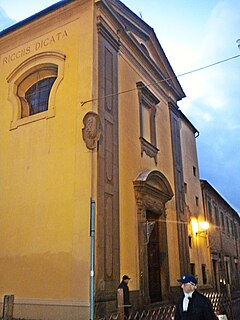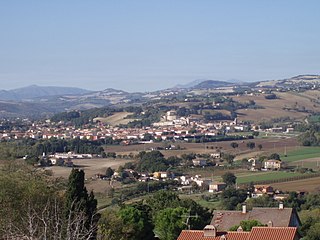
The architecture of cathedrals, basilicas and abbey churches is characterised by the buildings' large scale and follows one of several branching traditions of form, function and style that all ultimately derive from the Early Christian architectural traditions established in the Constantinian period.

The Papal Basilica of St. Paul Outside the Walls, commonly known as St. Paul's Outside the Walls, is one of Rome's four ancient, papal, major basilicas, along with the basilicas of St. John in the Lateran, St. Peter's, and St. Mary Major.

Norcia, traditionally known in English by its Latin name of Nursia, is a town and comune in the province of Perugia (Italy) in southeastern Umbria. Unlike many ancient towns, it is located in a wide plain abutting the Monti Sibillini, a subrange of the Apennines with some of its highest peaks, near the Sordo River, a small stream that eventually flows into the Nera. The town is popularly associated with the Valnerina.

The Basilica di Santa Maria Gloriosa dei Frari, usually just called the Frari, is a church located in the Campo dei Frari at the heart of the San Polo district of Venice, Italy. One of the most prominent churches in the city, it has the status of a minor basilica. The church is dedicated to the Assumption of Mary.

The Basilica of San Petronio is a minor basilica and church of the Archdiocese of Bologna located in Bologna, Emilia Romagna, northern Italy. It dominates Piazza Maggiore. The basilica is dedicated to the patron saint of the city, Saint Petronius, who was the bishop of Bologna in the fifth century. Construction began in 1390 and its main facade has remained unfinished since. The building was transferred from the city to the diocese in 1929; the basilica was finally consecrated in 1954. It has been the seat of the relics of Bologna's patron saint only since 2000; until then they were preserved in the Santo Stefano church of Bologna.

San Pietro is the name of a church and an abbey in the city of Perugia (Umbria), central Italy.

The Basilica of Sant'Ambrogio is a church in Milan, northern Italy.

San Giorgio Maggiore is a 16th-century Benedictine church on the island of the same name in Venice, northern Italy, designed by Andrea Palladio, and built between 1566 and 1610. The church is a basilica in the classical renaissance style and its brilliant white marble gleams above the blue water of the lagoon opposite the Piazzetta and forms the focal point of the view from every part of the Riva degli Schiavoni.

The Basilica of Santa Maria Maggiore is a major church in the upper town of Bergamo, Northern Italy.

The Basilica di San Zeno is a minor basilica of Verona, Northern Italy. Its fame rests partly on its architecture and partly upon the tradition that its crypt was the place of the marriage of Shakespeare's Romeo and Juliet. It stands adjacent to a Benedictine abbey, both dedicated to St Zeno of Verona.

San Francesco is a basilica church in Siena, Tuscany, Italy.

Fiesole Cathedral, officially the Cathedral of Saint Romulus of Fiesole, is a Roman Catholic cathedral in Fiesole, Tuscany, central Italy. It is the seat of the Bishop of Fiesole and is dedicated to Saint Romulus.

San Procolo is an early Gothic-style, Roman Catholic church and former monastery-hospital located on Via Massimo D'Azeglio #52 in central Bologna, region of Emilia Romagna, Italy.

The Minor Basilica of Santi Vicenzo e Caterina de' Ricci is a Catholic church, built in the 16th to 18th centuries, and located in the town of Prato, in Tuscany, Italy. Adjacent to the church is a 16th-century monastery.
The Sanctuary of the Madonna del Pilastrello is a Renaissance style, Roman Catholic minor basilica church in the city of Lendinara, in the province of Rovigo, region of Veneto, Italy.
Sarsina Cathedral is a Roman Catholic cathedral in Sarsina, a municipality in the province of Forlì-Cesena, region of Emilia-Romagna, Italy, dedicated to the Annunciation of the Virgin Mary. Formerly the seat of the Bishops of Sarsina, since 1986 it has been a co-cathedral of the Diocese of Cesena-Sarsina.
San Tommaso Apostolo is a Romanesque and Gothic-style, Roman Catholic church located in the town of Ascoli Piceno in the region of Marche, Italy.
Santa Maria in Piazza is a Roman Catholic church located in Piazza Matteoti in the town of Loro Piceno, province of Macerata, in the region of Marche, Italy.
Santa Maria Assunta di Castelnuovo is a Roman Catholic church located on Via Angelo Giunta in the town limits of Recanati, province of Macerata, in the region of Marche, Italy. It is the oldest church structure in town.
The Chiesa del Santissimo Redentore e Santa Maria is a Romanesque-style, deconsecrated Roman Catholic church located in the town of Visso, province of Macerata, region of Marche, Italy. Typically, the Italian title is S.S. Redentore e S. Maria.






















